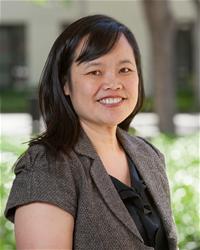
Dr. Scarlett Lin Gomez, lead researcher for the study
Researchers examined breast cancer incidence rates among seven Asian American ethnic groups in this new study.
FREMONT, CA (April 10, 2017) — In contrast to other US racial/ethnic groups, Asian Americans have experienced steadily increasing breast cancer rates over the past 15 years.
To better understand potential contributors to this increase, researchers at the Cancer Prevention Institute of California (CPIC) examined cancer incidenceIncidence refers to the occurrence of new cases of disease or injury in a population over a specified period of time. trends by age and stage among women from seven Asian American ethnic groups in California from 1988 through 2013. The findings were published in the April issue of Breast Cancer Research and Treatment.
Although prior research has examined subtype-specific incidence patterns among Asians/Pacific Islanders as whole, this is the first examination of subtype-specific incidence patterns among Asian American ethnicities and the variation among Asian American ethnic groups.
Asian Americans includes populations from nearly 30 countries with differing migration patterns, socioeconomic status, health behaviors and culture, all which contribute to differences in disease incidence. In this study, seven major ethnicities were evaluated: Chinese, Japanese, Korean, Filipino, Vietnamese, South Asians (Asian Indians and Pakistanis), and Southeast Asians (Cambodians, Laotians, Hmong, Thai).
All Asian Americans groups, with the exception of Japanese, experienced an overall incidence increase. The largest increase was observed among Koreans, South Asians and Southeast Asians. Rates increased for distant stage disease among Filipinas.
Among women over age 50, increases occurred in all Asian American ethnic groups while for women younger than 50 large increases occurred for Vietnamese and other Southeast Asian groups. Although breast cancer incidence rates in Asian American women as a whole were lower than rates for whites, the rates for Japanese and Filipinas under age 50 were comparable to rates for similarly aged white women.
Breast cancer incidence also varies by disease subtype defined by tumorA mass of cells that can be benign or malignant. expression of hormoneA chemical substance produced in the body that controls and regulates the activity of certain cells or organs. receptors and human epidermal growth factor receptor 2 (HER2). Within California, proportionally more breast cancers expressed HER2 in Korean, Filipino, Vietnamese, and Chinese women than in white women.
According to Scarlett Lin Gomez, the lead researcher of the study, “These patterns warrant additional attention to public health prioritization to target disparities in access to care, as well as further research in identifying relevant breast cancer risk factorsAnything that increases or decreases a person’s chance of developing a disease. for specific breast cancer subtypes. In particular, studies should investigate risk factors, perhaps early-life exposures, underlying the higher rates of breast cancer among young Filipino and Japanese women, with attention to possible geneticInherited characteristics. susceptibilityThe state or fact of being likely or liable to be influenced or harmed by a particular thing..”
Increasing trends of late-stage disease, particularly among Filipino, Korean and South Asian women, suggest a need for higher rates of mammography screening in these populations. Mammography utilization rates in California are slightly lower in Asian American women than in other racial/ethnic groups and among Asian Americans, Korean and South Asian women have the lowest mammography utilization, consistent with their higher rates of later-stage disease. The disproportionately high rates of some HER2 negative overexpressing subtypes also require better understanding, as this subtype tends to grow more quickly, spread more aggressively, and present more often as high-grade disease than the more common hormone receptors or HER2 negative tumors.
To conduct this study, researchers used data from the population-based California Cancer Registry in a state that is both the largest in the U.S. and has the most substantial population of Asian Americans. Comparison data were drawn for whites. From 1988-2013, researchers identified 45,721 invasive breast cancer cases among Asian Americans.
Other researchers who participated in this study from CPIC are Julie Von Behren, Meg McKinley, Christina A. Clarke, Salma Shariff-Marco, Iona Cheng, Peggy Reynolds and Sally L. Glaser.
This work was supported by the Stanford Cancer Institute and the National Cancer Institute’s Surveillance, Epidemiology and End Results Program under contract HHSN261201000140C awarded to the Cancer Prevention Institute of California.